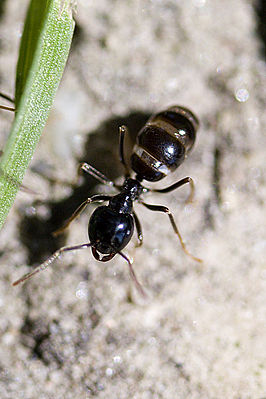Glossy black wood ant
| Glossy black wood ant | ||||||||||||
|---|---|---|---|---|---|---|---|---|---|---|---|---|

Gloss Black Wood Ant Worker |
||||||||||||
| Systematics | ||||||||||||
|
||||||||||||
| Scientific name | ||||||||||||
| Lasius fuliginosus | ||||||||||||
| ( Latreille , 1798) |
The Lasius fuliginosus or cardboard ant ( Lasius fuliginosus is) a very common occurring representatives of garden ants ( Lasius ) in Central Europe . It is counted to the subgenus Dendrolasius .
features
The workers are 4 to 6, the males 4.5 to 5, the queens 6 to 6.5 millimeters long. The queens are therefore hardly larger than large workers, but the queen's abdomen swells when the colony is established during egg production ( physogastry ). As you can already see from the German name, Lasius fuliginosus has a deep black color, which is intensified by a strong gloss. The mandibles and antennae shafts , however, are more brown.
distribution and habitat
Their distribution area extends over large parts of Europe and Asia . In Central Europe it is everywhere and in some regions quite frequently. The nests of the glossy black wooden ant are mostly in dead wood , but not only in hollow tree trunks, but also in man-made fence posts or roof beams. This is why the species is one of the harmful ants.
Way of life
The sex animals swarm between June and July. Sometimes the young queen is adopted by the mother's nest or another nest of this type. Most of the time, however, the young queen parasitizes an already existing nest of the yellow shadow ant ( Lasius umbratus ). She penetrates a queenless nest and lays her eggs there, which are taken care of by the Lasius umbratus workers. Over time, all auxiliary ants die and the nest is only inhabited by Lasius fuliginosus . What is special is that the yellow shadow ant is itself a social parasite and also needs auxiliary ants when establishing a nest. That is why Lasius fuliginosus is sometimes referred to as a hypersocial parasite.
With up to two million workers, the polygynous states can become very populous, and several branch nests develop, each with one or more queens.
A sweet smell can be perceived near the nests. The ants produce dendrolasin and undecan in their mandibular glands . These secretions are released when the nest is disturbed or threatened. What is just a sweet smell for humans is an efficient method for the ants to put the entire nest on alert. In addition, this smell has a very strong deterrent effect on Formica and other Lasius species and is even toxic to them .
nutrition
This species feeds almost exclusively on the honeydew of the aphids. Frequently crowded ant trails form to nearby trees. The gaster swells in the workers strongly from the food intake.
Nest building
The workers build a so-called cardboard nest from a mass of different solids such as B. chewed wood and almost 50 percent sugar . They gnaw cavities in the wood and fill them with this blackish mass. The cardboard-like structure is the basis for a mushroom grown by Lasius fuliginosus . The fine fungal threads of Cladosporium myrmecophilum overgrow and penetrate the thin walls and reinforce them in many ways. The sole purpose of this mushroom cultivation is the stabilization of the nest walls by the net-like mushroom network. Lasius fuliginosus does not feed on this fungus, as is often mistakenly believed.
swell
- Heiko Bellmann : bees, wasps, ants. Hymenoptera of Central Europe. Franckh-Kosmos, Stuttgart 1995, ISBN 3-440-09690-4 .
Web links
- Lasius (Dendrolasius) fuliginosus in Fauna Europaea
- Video: Amphotis marginata beetle (Nitidulidae) - begging for food at Lasius fuliginosus . Institute for Scientific Film (IWF) 1973, made available by the Technical Information Library (TIB), doi : 10.3203 / IWF / E-2014 .
- Video: begging for food in ants (Lasius fuliginosus) - gloss beetle (Amphotis marginata) . Institute for Scientific Film (IWF) 1976, made available by the Technical Information Library (TIB), doi : 10.3203 / IWF / K-21 .